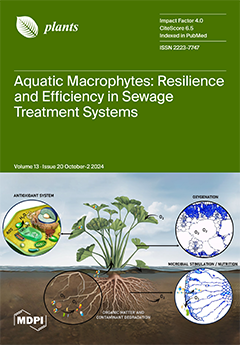Salinity represents a considerable environmental risk, exerting deleterious effects on horticultural crops. Nanotechnology has recently emerged as a promising avenue for enhancing plant tolerance to abiotic stress. Among nanoparticles, cerium oxide nanoparticles (CeO
2 NPs) have been demonstrated to mitigate certain stress effects,
[...] Read more.
Salinity represents a considerable environmental risk, exerting deleterious effects on horticultural crops. Nanotechnology has recently emerged as a promising avenue for enhancing plant tolerance to abiotic stress. Among nanoparticles, cerium oxide nanoparticles (CeO
2 NPs) have been demonstrated to mitigate certain stress effects, including salinity. In the present study, the impact of CeO
2 NPs (0, 25, and 100 mg L
−1) on various morphological traits, photosynthetic pigments, biochemical parameters, and the essential oil profile of spearmint plants under moderate (50 mM NaCl) and severe (100 mM NaCl) salinity stress conditions was examined. As expected, salinity reduced morphological parameters, including plant height, number of leaves, fresh and dry weight of leaves and shoots, as well as photosynthetic pigments, in comparison to control. Conversely, it led to an increase in the content of proline, total phenols, malondialdehyde (MDA), hydrogen peroxide (H
2O
2), and antioxidant enzyme activities. In terms of CeO
2 NP applications, they improved the salinity tolerance of spearmint plants by increasing chlorophyll and carotenoid content, enhancing antioxidant enzyme activities, and lowering MDA and H
2O
2 levels. However, CeO
2 NPs at 100 mg L
−1 had adverse effects on certain physiological parameters, highlighting the need for careful consideration of the applied concentration of CeO
2 NPs. Considering the response of essential oil compounds, combination of salinity stress and CeO
2 treatments led to an increase in the concentrations of L-menthone, pulegone, and 1,8-cineole, which are the predominant compounds in spearmint essential oil. In summary, foliar application of CeO
2 NPs strengthened the resilience of spearmint plants against salinity stress, offering new insights into the potential use of CeO
2 NP treatments to enhance crop stress tolerance.
Full article






